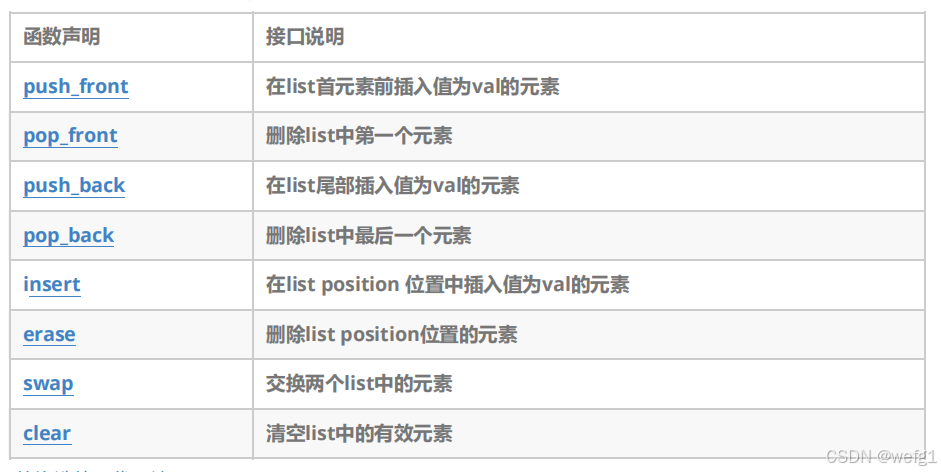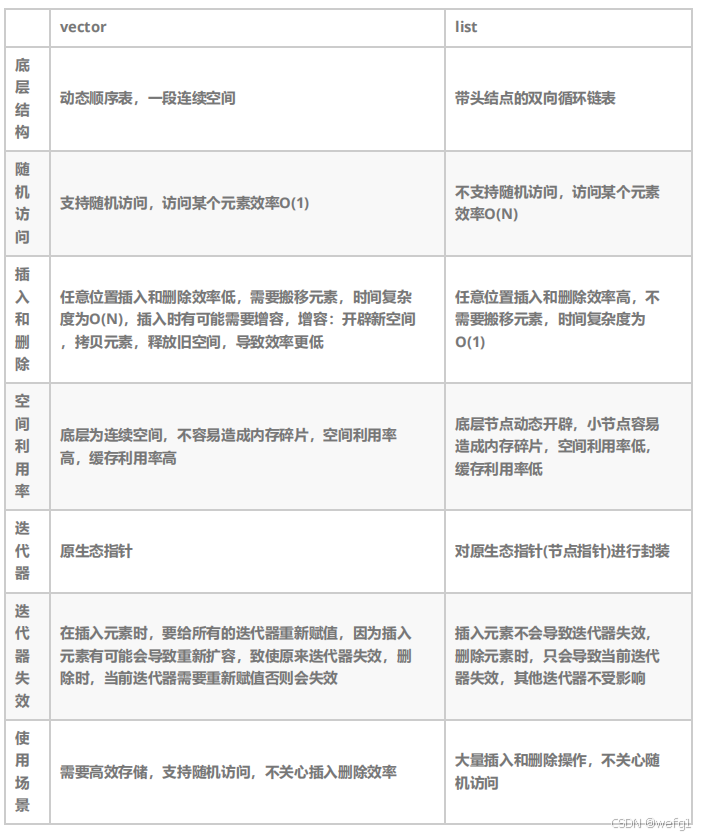目录
[list 的使用](#list 的使用)
[list 的构造函数](#list 的构造函数)
[list iterator的使用](#list iterator的使用)
[list capacity](#list capacity)
[list element access](#list element access)
[list modifiers](#list modifiers)
[与 vector 的比较](#与 vector 的比较)
list 的使用
list 的构造函数

list iterator的使用
此处,大家可暂时将迭代器理解成一个指针,该指针指向list中的某个节点。

【注意】
begin与end为正向迭代器,对迭代器执行++操作,迭代器向后移动
rbegin(end)与rend(begin)为反向迭代器,对迭代器执行++操作,迭代器向前移动
list capacity

list element access

list modifiers

splice 函数

作用:将 x 的所有(部分)结点转移到 position 位置之前(上面第二个重载函数是转移一个)(可以将自己的一部分转移到自己的另一部分)
示例:
cpp
for (int i=1; i<=4; ++i)
mylist1.push_back(i); // mylist1: 1 2 3 4
for (int i=1; i<=3; ++i)
mylist2.push_back(i*10); // mylist2: 10 20 30
it = mylist1.begin();
++it; // points to 2
mylist1.splice (it, mylist2); // mylist1: 1 10 20 30 2 3 4
// mylist2 (empty)
// "it" still points to 2 (the 5th element)remove 函数
作用:找出某个值,把这个值所在的结点删除。如果没有这个值,不会报错。
示例:
cpp
int myints[]= {17,89,7,14};
std::list<int> mylist (myints,myints+4);
mylist.remove(89); // mylist : 17,7,14list的迭代器失效问题
前面说过,此处大家可将迭代器暂时理解成类似于指针,迭代器失效即迭代器所指向的节点的无效,即该节点被删除了。因为list的底层结构为带头双向循环链表 ,因此在list中进行插入时是不会导致list的迭代器失效的,只有在删除时才会失效,并且失效的只是指向被删除节点的迭代器,其他迭代器不会受到影响。
cpp
void TestListIterator1()
{
int array[] = { 1, 2, 3, 4, 5, 6, 7, 8, 9, 0 };
list<int> l(array, array+sizeof(array)/sizeof(array[0]));
auto it = l.begin();
while (it != l.end())
{
// erase()函数执行后,it所指向的节点已被删除,因此it无效,在下一次使用it时,必须先给
//其赋值
l.erase(it);
++it;
}
}
// 改正
void TestListIterator()
{
int array[] = { 1, 2, 3, 4, 5, 6, 7, 8, 9, 0 };
list<int> l(array, array+sizeof(array)/sizeof(array[0]));
auto it = l.begin();
while (it != l.end())
{
l.erase(it++); // it = l.erase(it);
}
}与 vector 的比较

模拟实现
cpp
#include<iostream>
using namespace std;
namespace Mylist
{
// List的节点类
template<class T>
struct ListNode
{
ListNode(const T& val = T())
{
_val = val;
}
ListNode<T>* _pPre;
ListNode<T>* _pNext;
T _val;
};
//List的迭代器类
template<class T, class Ref, class Ptr>
struct ListIterator
{
typedef ListNode<T>* PNode;
typedef ListIterator<T, Ref, Ptr> Self;// Ref:T&,Ptr:T*
ListIterator(PNode pNode = nullptr)
{
_pNode = pNode;
}
ListIterator(const Self& l)
{
_pNode = l._pNode;
}
Ref operator*()
{
return _pNode->_val;
}
//operator-> 的特殊规则
//C++ 标准规定,operator-> 会被递归调用,直到返回一个
//普通指针(或具有 operator-> 的类
//型),然后编译器会自动使用 -> 访问成员。
Ptr operator->()
{
return &_pNode->_val;
}
Self& operator++()
{
return _pNode->_pNext;
}
Self operator++(int)
{
Self tmp = _pNode;
_pNode = _pNode->_pNext;
return tmp;
}
Self& operator--()
{
return _pNode->_pPre;
}
Self& operator--(int)
{
Self tmp = _pNode;
_pNode = _pNode->_pPre;
return tmp;
}
bool operator!=(const Self& l)
{
return _pNode != l._pNode;
}
bool operator==(const Self& l)
{
return _pNode == l._pNode;
}
PNode _pNode;
};
//list类
template<class T>
class list
{
typedef ListNode<T> Node;
typedef Node* PNode;
public:
typedef ListIterator<T, T&, T*> iterator;
typedef ListIterator<T, const T&, const T&> const_iterator;
public:
///////////////////////////////////////////////////////////////
// List的构造
list()
{
CreateHead();
_pHead->_pNext = _pHead;
_pHead->_pPre = _pHead;
sz = 0;
}
list(int n, const T& value = T())
{
CreateHead();
_pHead->_pNext = _pHead;
_pHead->_pPre = _pHead;
sz = 0;
while (n--)
{
push_back(value);
}
}
template <class Iterator>
list(Iterator first, Iterator last)
{
CreateHead();
_pHead->_pNext = _pHead;
_pHead->_pPre = _pHead;
sz = 0;
while (first != last)
{
push_back(*first);
first++;
}
}
list(const list<T>& l)
{
CreateHead();
_pHead->_pNext = _pHead;
_pHead->_pPre = _pHead;
sz = 0;
const_iterator it = l.begin();
while (it != l.end())
{
push_back(*it);
it++;
}
}
list<T>& operator=(list<T> l)
{
swap(l);
return *this;
}
~list()
{
clear();
delete _pHead;
}
///////////////////////////////////////////////////////////////
// List Iterator
iterator begin()
{
return _pHead->_pNext;
}
iterator end()
{
return _pHead;
}
const_iterator begin() const
{
return _pHead->_pNext;
}
const_iterator end() const
{
return _pHead;
}
///////////////////////////////////////////////////////////////
// List Capacity
size_t size()const
{
return sz;
}
bool empty()const
{
return sz == 0;
}
////////////////////////////////////////////////////////////
// List Access
T& front()
{
return _pHead->_pNext->_val;
}
const T& front()const
{
return _pHead->_pNext->_val;
}
T& back()
{
return _pHead->_pPre->_val;
}
const T& back()const
{
return _pHead->_pPre->_val;
}
////////////////////////////////////////////////////////////
// List Modify
void push_back(const T& val) { insert(end(), val); }
void pop_back() { erase(--end()); }
void push_front(const T& val) { insert(begin(), val); }
void pop_front() { erase(begin()); }
// 在pos位置前插入值为val的节点
iterator insert(iterator pos, const T& val)
{
Node* NewNode = new Node;
NewNode->_val = val;
Node* cur = pos._pNode;
Node* prev = cur->_pPre;
prev->_pNext = NewNode;
NewNode->_pPre = prev;
NewNode->_pNext = cur;
cur->_pPre = NewNode;
sz++;
return NewNode;
}
// 删除pos位置的节点,返回该节点的下一个位置
iterator erase(iterator pos)
{
Node* cur = pos._pNode;
Node* prev = cur->_pPre;
Node* next = cur->_pNext;
prev->_pNext = next;
next->_pPre = prev;
delete cur;
return next;
}
void clear()
{
iterator it = begin();
while (it != end())
{
it = erase(it);
}
sz = 0;
}
void swap(list<T>& l)
{
iterator tmp = l._pHead;
l._pHead = _pHead;
_pHead = tmp._pNode;
size_t tmp1 = l.sz;
l.sz = sz;
sz = tmp1;
}
private:
void CreateHead()
{
_pHead = new Node;
}
PNode _pHead;
size_t sz;
};
};